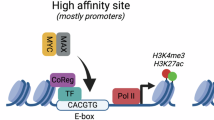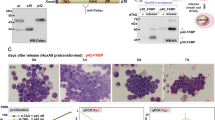Abstract
Myc, a key regulator of cellular proliferation, differentiation and apoptosis, exerts its biological functions by activating or suppressing the transcription of specific sets of target genes. C/EBP transcription factors play important roles during differentiation of various cell types and have been identified as critical targets for v-Myc- and c-Myc-dependent suppression of myeloid and fat cell differentiation. Here, we have addressed the mechanism by which v-Myc suppresses the activity of C/EBPβ. We show that v-Myc is recruited to the aminoterminal domain of C/EBPβ and interferes with the cooperation of C/EBPβ and the co-activator p300 by preventing C/EBPβ-induced phosphorylation of p300. We have identified the protein kinase responsible for C/EBPβ-induced phosphorylation of p300 as homeo-domain interacting protein kinase 2 (HIPK2) and show that v-Myc displaces the kinase from the C/EBPβ-p300 complex. Overall, our findings that the modulation of the C/EBPβ-induced phosphorylation of p300 as a new mechanism of transcriptional suppression by v-Myc.
This is a preview of subscription content, access via your institution
Access options
Subscribe to this journal
Receive 50 print issues and online access
$259.00 per year
only $5.18 per issue
Buy this article
- Purchase on SpringerLink
- Instant access to full article PDF
Prices may be subject to local taxes which are calculated during checkout





Similar content being viewed by others
References
Adhikary S, Eilers M . (2005). Transcriptional regulation and transformation by Myc proteins. Nat Rev Mol Cell Biol 6: 635–645.
Aikawa Y, Nguyen LA, Isono K, Takakura N, Tagata Y, Schmitz ML et al. (2006). Roles of HIPK1 and HIPK2 in AML1- and p300-dependent transcription, hematopoiesis and blood vessel formation. EMBO J 25: 3955–3965.
Buck M, Poli V, van der Geer P, Chojkier M, Hunter T . (1999). Phosphorylation of rat serine 105 or mouse threonine 217 in C/EBP beta is required for hepatocyte proliferation induced by TGF alpha. Mol Cell 4: 1087–1092.
Bundy LM, Sealy L . (2003). CCAAT/enhancer binding protein beta (C/EBPbeta)-2 transforms normal mammary epithelial cells and induces epithelial to mesenchymal transition in culture. Oncogene 22: 869–883.
Calkhoven CF, Müller C, Leutz A . (2000). Translational control of C/EBPα and C/EBPβ isoform expression. Genes Dev 14: 1920–1932.
Cao Z, Umek RM, McKnight SL . (1991). Regulated expression of three C/EBP isoforms during adipose conversion of 3T3-L1 cells. Genes Dev 5: 1538–1552.
Ceseña TI, Cardinaux JR, Kwok R, Schwartz J . (2007). CCAAT/enhancer-binding protein (C/EBP) beta is acetylated at multiple lysines: acetylation of C/EBPbeta at lysine 39 modulates its ability to activate transcription. J Biol Chem 282: 956–967.
Cowling VH, Cole MD . (2006). Mechanism of transcriptional activation by the Myc oncoproteins. Semin Cancer Biol 16: 242–252.
Dang CV, O'Donnell KA, Zeller KI, Nguyen T, Osthus RC, Li F . (2006). The c-Myc target gene network. Semin Cancer Biol 16: 253–264.
Darlington GJ, Ross SE, MacDougald OA . (1998). The role of C/EBP genes in adipocyte differentiation. J Biol Chem 273: 30057–30060.
Descombes P, Schibler U . (1991). A liver-enriched transcriptional activator protein, LAP, and a transcriptional inhibitory protein, LIP, are translated from the same mRNA. Cell 67: 569–579.
Di Stefano V, Rinaldo C, Sacchi A, Soddu S, D′Orazi G . (2004). Homeodomain-interacting protein kinase-2 activity and p53 phosphorylation are critical events for cisplatin-mediated apoptosis. Exp Cell Res 293: 311–320.
Eaton EM, Sealy L . (2003). Modification of CCAAT/enhancer-binding protein-beta by the small ubiquitin-like modifier (SUMO) family members, SUMO-2 and SUMO-3. J Biol Chem 278: 33416–33421.
Eckner R, Ewen ME, Newsome D, Gerdes M, DeCaprio JA, Bentley-Lawrence J et al. (1994). Molecular cloning and functional analysis of the adenovirus E1A-associated 300-kD protein (p300) reveals a protein with properties of a transcriptional adaptor. Genes Dev 8: 869–884.
Eilers M, Eisenman RN . (2008). Myc's broad reach. Genes Dev 22: 2755–2766.
Feng XH, Liang YY, Liang M, Zhai W, Lin X . (2002). Direct interaction of c-Myc with Smad2 and Smad3 to inhibit TGF-beta-mediated induction of the CDK inhibitor p15(Ink4B). Mol Cell 9: 133–143.
Freytag SO, Geddes TJ . (1992). Reciprocal regulation of adipogenesis by Myc and C/EBP alpha. Science 256: 379–382.
Gartel AL, Ye X, Goufman E, Shianov P, Hay N, Najmabadi F et al. (2001). Myc represses the p21 (WAF1/CIP1) promoter and interacts with Sp1/Sp3. Proc Natl Acad Sci USA 98: 4510–4515.
Gombart AF, Hofmann WK, Kawano S, Takeuchi S, Krug U, Kwok SH et al. (2002). Mutations in the gene encoding the transcription factor CCAAT/enhancer binding protein alpha in myelodysplastic syndromes and acute myeloid leukemias. Blood 99: 1332–1340.
Gomis RR, Alarcón C, Nadal C, Van Poznak C, Massagué J . (2006). C/EBPbeta at the core of the TGFbeta cytostatic response and its evasion in metastatic breast cancer cells. Cancer Cell 10: 203–214.
Heath VJ, Gillespie DA, Crouch DH . (2000). Inhibition of the terminal stages of adipocyte differentiation by c-Myc. Exp Cell Res 254: 91–98.
Herold S, Wanzel M, Beuger V, Frohme C, Beul D, Hillukkala T et al. (2002). Negative regulation of the mammalian UV response by Myc through association with Miz-1. Mol Cell 10: 509–521.
Hoffman-Liebermann B, Liebermann DA . (1991). Interleukin-6- and leukemia inhibitory factor-induced terminal differentiation of myeloid leukemia cells is blocked at an intermediate stage by constitutive c-myc. Mol Cell Biol 11: 2375–2381.
Hofmann TG, Möller A, Sirma H, Zentgraf H, Taya Y, Dröge W et al. (2002). Regulation of p53 activity by its interaction with homeodomain-interacting protein kinase-2. Nat Cell Biol 4: 1–10.
Izumi H, Molander C, Penn LZ, Ishisaki A, Kohno K, Funa K . (2001). Mechanism for the transcriptional repression by c-Myc on PDGF beta-receptor. J Cell Science 114: 1533–1544.
Johnson PF . (2005). Molecular stop signs: regulation of cell-cycle arrest by C/EBP transcription factors. J Cell Sci 118: 2545–2555.
Joo M, Park GY, Wright JG, Blackwell TS, Atchison ML, Christman JW . (2004). Transcriptional regulation of the cyclooxygenase-2 gene in macrophages by PU.1. J Biol Chem 279: 6658–6665.
Kleine-Kohlbrecher D, Adhikary S, Eilers M . (2006). Mechanisms of transcriptional repression by Myc. Curr Top Microbiol Immunol 302: 51–62.
Kowenz-Leutz E, Leutz A . (1999). A C/EBP beta isoform recruits the SWI/SNF complex to activate myeloid genes. Mol Cell 4: 735–743.
Lane MD, Tang QQ, Jiang MS . (1999). Role of the CCAAT enhancer binding proteins (C/EBPs) in adipocyte differentiation. Biochem Biophys Res Commun 266: 677–683.
Lee CM, Reddy EP . (1999). The v-myc oncogene. Oncogene 18: 2997–3003.
Lin F-T, Lane MD . (1992). Antisense CCAAT/enhancer-binding protein RNA suppresses coordinate gene expression and triglyceride accumulation during differentiation of 3T3-L1 preadipocytes. Genes Dev 6: 533–544.
Mink S, Haenig B, Klempnauer K-H . (1997). Interaction and functional collaboration of p300 and C/EBPβ. Mol Cell Biol 17: 6609–6617.
Mink S, Mutschler B, Weiskirchen R, Bister K, Klempnauer K-H . (1996). A novel function for Myc: inhibition of C/EBP-dependent gene activation. Proc Natl Acad Sci USA 93: 6635–6640.
Müller C, Kowenz-Leutz E, Grieser-Ade S, Graf T, Leutz A . (1995). NF-M (chicken C/EBPβ) induces eosinophilic differentiation and apoptosis in a hematopoietic progenitor cell line. EMBO J 14: 6127–6235.
Nakajima T, Kinoshita S, Sasagawa T, Sasaki K, Naruto M, Kishimoto T et al. (1993). Phosphorylation at threonine-235 by a ras-dependent mitogen-activated protein kinase cascade is essential for transcription factor NF-IL6. Proc Natl Acad Sci USA 90: 2207–2211.
Nerlov C . (2004). C/EBPalpha mutations in acute myeloid leukemias. Nat Rev Cancer 4: 394–400.
Nerlov C . (2007). The C/EBP family of transcription factors: a paradigm for interaction between gene expression and proliferation control. Trends Cell Biol 17: 318–324.
Otto TC, Lane MD . (2005). Adipose development: from stem cell to adipocyte. Crit Rev Biochem Mol Biol 40: 229–242.
Pabst T, Mueller BU, Zhang P, Radomsky HS, Narravula S, Schnittger S et al. (2001). Dominant-negative mutations of CEBPA, encoding CCAAT/enhancer binding protein-alpha (C/EBPα), in acute myeloid leukemia. Nat Genet 27: 263–270.
Pedersen TA, Kowenz-Leutz E, Leutz A, Nerlov C . (2001). Cooperation between C/EBPα, TBP/TFIIB and SWI/SNF recruiting domains is required for adipocyte differentiation. Genes Dev 15: 3208–3216.
Ramji DP, Foka P . (2002). CCAAT/enhancer-binding proteins: structure, function and regulation. Biochem J 365: 561–575.
Reiter F, Hartl M, Karagiannidis AI, Bister K . (2007). WS5, a direct target of oncogenic transcription factor Myc, is related to human melanoma glycoprotein genes and has oncogenic potential. Oncogene 26: 1769–1779.
Rinaldo C, Prodosmo A, Siepi F, Soddu S . (2007). HIPK2: a multitalented partner for transcription factors in DNA damage response and development. Biochem Cell Biol 85: 411–418.
Schwartz C, Beck K, Mink S, Schmolke M, Budde B, Wenning D et al. (2003). Recruitment of p300 by C/EBPbeta triggers phosphorylation of p300 and modulates coactivator activity. EMBO J 22: 882–892.
Seoane J, Pouponnot C, Staller P, Schader M, Eilers M, Massague J . (2001). TGFbeta influences Myc, Miz-1 and Smad to control the CDK inhibitor p15INK4b. Nat Cell Biol 3: 400–408.
Shrivastava A, Saleque S, Kalpana GV, Artandi S, Goff SP, Calame K . (1993). Inhibition of transcriptional regulator Yin-Yang-1 by association with c-Myc. Science 262: 1889–1892.
Staller P, Peukert K, Kiermaier A, Seoane J, Lukas J, Karsunky H et al. (2001). Repression of p15INK4b expression by Myc through association with Miz-1. Nat Cell Biol 3: 392–399.
Symonds G, Klempnauer K-H, Snyder M, Moscovici G, Moscovici C, Bishop JM . (1986). Coordinate regulation of myelomonocytic phenotype by v-myb and v-myc. Mol Cell Biol 6: 1796–1802.
Tang QQ, Otto TC, Lane MD . (2003). CCAAT/enhancer-binding protein beta is required for mitotic clonal expansion during adipogenesis. Proc Natl Acad Sci USA 100: 850–855.
Tinel M, Berson A, Elkahwaji J, Cresteil T, Beaune P, Pessayre D . (2003). Downregulation of cytochromes P450 in growth-stimulated rat hepatocytes:role of c-Myc induction and impaired C/EBP binding to DNA. J. Hepatol 39: 171–178.
Trautwein C, Caelles C, van der Geer P, Hunter T, Karin M, Chojkier M . (1993). Transactivation by NF-IL6/LAP is enhanced by phosphorylation of its activation domain. Nature 364: 544–547.
Wanzel M, Herold S, Eilers M . (2003). Transcriptional repression by Myc. Trends Cell Biol 13: 146–150.
Xu M, Nie L, Kim SH, Sun XH . (2003). STAT5-induced Id-1 transcription involves recruitment of HDAC1 and deacetylation of C/EBPbeta. EMBO J 22: 893–904.
Yeh W-C, Cao Z, Classon M, McKnight SL . (1995). Cascade regulation of terminal adipocyte differentiation by three members of the C/EBP family of leucine zipper proteins. Genes Dev 9: 168–181.
Zahnow CA, Cardiff RD, Laucirica R, Medina D, Rosen JM . (2001). A role for CCAAT/enhancer binding protein beta-liver-enriched inhibitory protein in mammary epithelial cell proliferation. Cancer Res 61: 261–269.
Zhang DE, Zhang P, Wang ND, Hetherington CJ, Darlington GJ, Tenen DG . (1997). Absence of granulocyte colony-stimulating factor signaling and neutrophil development in CCAAT enhancer binding protein α-deficient mice. Proc Natl Acad Sci USA 94: 569–574.
Acknowledgements
We thank B Berkenfeld for excellent technical assistance and K Bister, D Crouch, G D'Orazi, R Eckner, T Hofmann and I Kitabayashi for plasmids, cells and antibodies. This work was supported by a grant from the DFG (KL461/12-1). KB and SC were supported by fellowships from the Graduate School of Chemistry (GSC-MS) at the University of Münster.
Author information
Authors and Affiliations
Corresponding author
Additional information
Supplementary Information accompanies the paper on the Oncogene website (http://www.nature.com/onc)
Rights and permissions
About this article
Cite this article
Steinmann, S., Schulte, K., Beck, K. et al. v-Myc inhibits C/EBPβ activity by preventing C/EBPβ-induced phosphorylation of the co-activator p300. Oncogene 28, 2446–2455 (2009). https://doi.org/10.1038/onc.2009.90
Received:
Revised:
Accepted:
Published:
Issue date:
DOI: https://doi.org/10.1038/onc.2009.90



